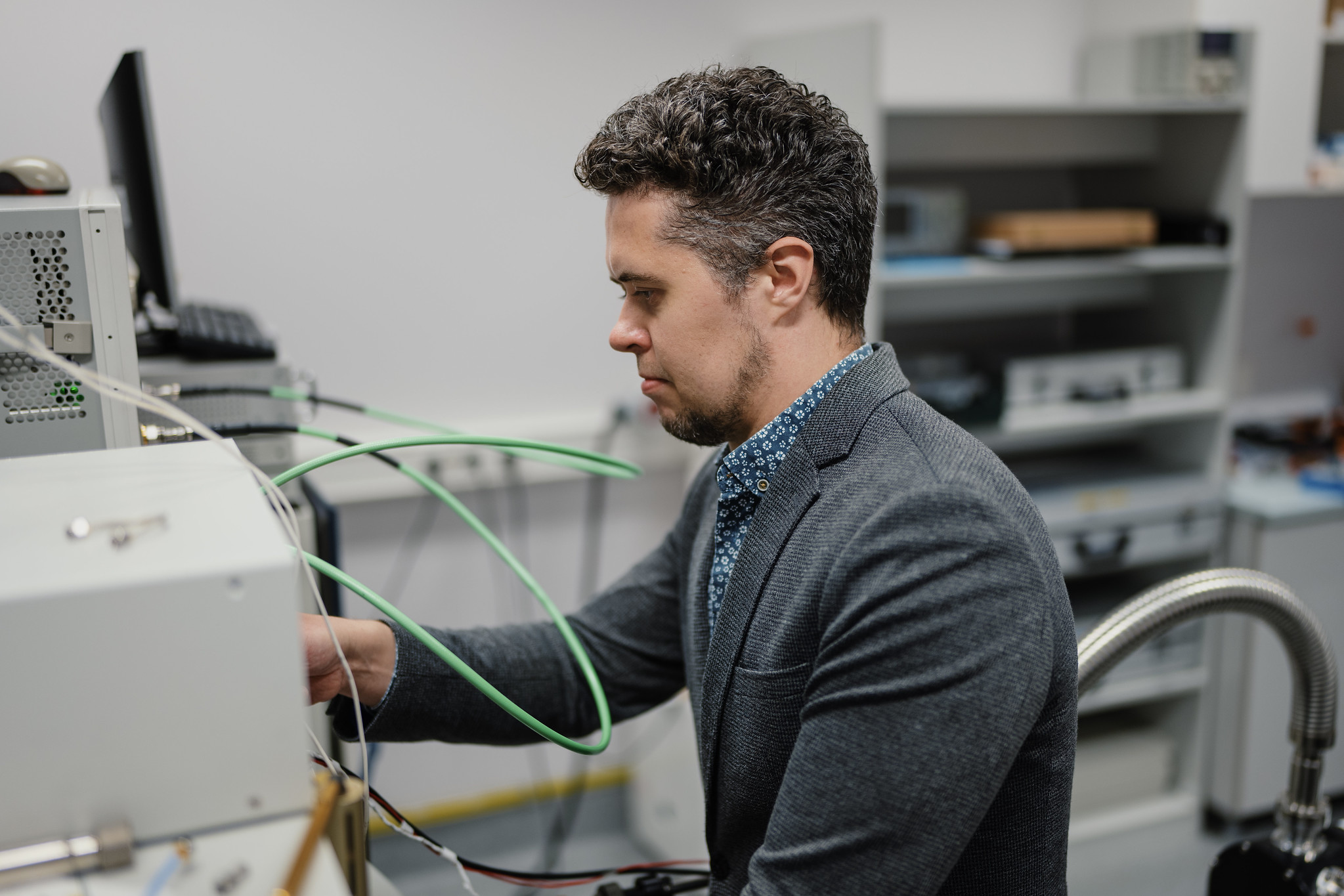An ‘almost perfect’ diagnosis of an elusive global killer

The new technology correctly identified 99% of confirmed bacterial sepsis cases, 92% of confirmed viral sepsis cases, and predicted sepsis in 74% of clinically suspected but undiagnosed cases.
Excellent accuracy – the sepsis diagnostic tool combines genetic sequencing with analysis of patients’ immune responses.
Sepsis – a condition in which the immune system overreacts to infection – is estimated to cause 20% of deaths worldwide each year and somewhere between 20 and 50% of hospital deaths in the United States. Despite the frequency and severity of the disease, it is difficult to identify and effectively treat.

Chaz Langelier, MD, PhD, assistant professor of medicine in UCSF’s Division of Infectious Diseases and a CZ Biohub investigator, is the senior author of the study that describes the highly accurate sepsis diagnostic tool. Author: CZ Biohub
The disease can lead to reduced blood flow to major organs, widespread inflammation, and impaired blood clotting. As a result, sepsis can lead to shock, organ failure, and death if not diagnosed and treated in time. However, determining which pathogen is causing sepsis, whether the infection is in the bloodstream or elsewhere in the body, can be difficult. In addition, it can be difficult to assess whether a patient actually has an infection in many cases with symptoms that resemble sepsis.
Researchers from the Chan Zuckerberg Biohub, the Chan Zuckerberg Initiative and University of California, San Francisco have now created a new diagnostic method that uses machine learning to analyze advanced genomic data from both the host and the pathogen to recognize and predict sepsis cases. The method is reported to be surprisingly accurate and could greatly exceed current diagnostic skills. The researchers’ findings were recently published in a journal Microbiologist of naturein
“Sepsis is one of the top 10 public health challenges facing humanity,” said senior author Chaz Langelier, MD, PhD, assistant professor of medicine in UCSF’s Division of Infectious Diseases and a CZ Biohub investigator. “One of the key problems in sepsis is diagnosis. Existing diagnostic tests are unable to detect the two-sided nature of the disease – the infection itself and the host’s immune response to the infection.”
Current sepsis diagnosis focuses on identifying the bacteria by growing them in culture, a process that is “necessary for appropriate antibiotic therapy, which is critical for survival in sepsis,” according to the researchers behind the new method. But the cultivation of these pathogens takes a long time and does not always allow to correctly identify the bacterium causing the infection. As with viruses, PCR tests can detect that viruses are infecting a patient, but do not always identify the specific virus causing sepsis.
“This results in doctors not being able to determine the cause of sepsis in about 30 to 50 percent of cases,” Langelier said. “It also leads to a mismatch in terms of antibiotic treatment and the pathogen causing the problem.”
In the absence of an accurate diagnosis, doctors often prescribe a cocktail of antibiotics to stop the infection, but the overuse of antibiotics has led to an increase in antibiotic resistance worldwide. “As physicians, we never want to miss a single case of infection,” said Carolyn Calfee, MD, MAS, professor of medicine and anesthesia at UCSF and co-senior author of the new study. “But if we had a test that could help us identify exactly who doesn’t have an infection, then it could help us limit the use of antibiotics in those cases, which would be very good for all of us.”
Elimination of ambiguity
The researchers analyzed whole blood and[{” attribute=””>plasma samples from more than 350 critically ill patients who had been admitted to UCSF Medical Center or the Zuckerberg San Francisco General Hospital between 2010 and 2018.
But rather than relying on cultures to identify pathogens in these samples, a team led by CZ Biohub scientists Norma Neff, Ph.D., and Angela Pisco, Ph.D., instead used metagenomic next-generation sequencing (mNGS). This method identifies all the nucleic acids or genetic data present in a sample, then compares those data to reference genomes to identify the microbial organisms present. This technique allows scientists to identify genetic material from entirely different kingdoms of organisms – whether bacteria, viruses, or fungi – that are present in the same sample.
However, detecting and identifying the presence of a pathogen alone isn’t enough for accurate sepsis diagnosis, so the Biohub researchers also performed transcriptional profiling – which quantifies gene expression – to capture the patient’s response to infection.
Next they applied machine learning to the mNGS and transcriptional data to distinguish between sepsis and other critical illnesses and thus confirm the diagnosis. Katrina Kalantar, Ph.D., a lead computational biologist at CZI and co–first author of the study, created an integrated host–microbe model trained on data from patients in whom either sepsis or non-infectious systemic inflammatory illnesses had been established, which enabled sepsis diagnosis with very high accuracy.
“We developed the model by looking at a bunch of metagenomics data alongside results from traditional clinical tests,” Kalantar explained. To start, the researchers identified changes in gene expression between patients with confirmed sepsis and non-infectious systemic inflammatory conditions that appear clinically similar, then used machine learning to identify the genes that could best predict those changes.
The researchers found that when traditional bacterial culture identified a sepsis-causing pathogen, there was usually an overabundance of genetic material from that pathogen in the corresponding plasma sample analyzed by mNGS. With that in mind, Kalantar programmed the model to identify organisms present in disproportionately high abundance compared to other microbes in the sample, and to then compare those to a reference index of well-known sepsis-causing microbes.
“In addition to that, we also noted any viruses that were detected, even if they were at lower levels, because those really shouldn’t be there,” Kalantar explained. “With this relatively straightforward set of rules, we were able to do pretty well.”
‘Almost perfect’ performance
The researchers found that the mNGS method and their corresponding model worked better than expected: They were able to identify 99% of confirmed bacterial sepsis cases, 92% of confirmed viral sepsis cases, and were able to predict sepsis in 74% of clinically suspected cases that hadn’t been definitively diagnosed.
“We were expecting good performance, or even great performance, but this was almost perfect,” said Lucile Neyton, Ph.D., a postdoctoral researcher in the Calfee lab and co–first author of the study. “By using this approach, we get a pretty good idea of what is causing the disease, and we know with relatively high confidence if a patient has sepsis or not.”
The team was also excited to discover that they could use this combined host-response and microbe detection method to diagnose sepsis using plasma samples, which are routinely collected from most patients as part of standard clinical care. “The fact that you can actually identify sepsis patients from this widely available, easy-to-collect sample type has big implications in terms of practical utility,” Langelier said.
The idea for the work stemmed from a previous Proceedings of the National Academy of Sciences study by Langelier, Kalantar, Calfee, UCSF researcher and CZ Biohub President Joe DeRisi, Ph.D., and their colleagues, in which they used mNGS to effectively diagnose lower respiratory tract infections in critically ill patients. Because the method worked so well, “we wanted to see if the same type of approach could work in the context of sepsis,” said Kalantar.
Broader implications
The team hopes to build upon this successful diagnostic technique by developing a model that can also predict antibiotic resistance from pathogens detected with this method. “We’ve had some success doing that for respiratory infections, but no one has come up with a good approach for sepsis,” Langelier said.
Furthermore, the researchers hope to eventually be able to predict outcomes of patients with sepsis, “such as mortality or length of stay in the hospital, which would provide key information that would allow clinicians to better care for their patients and match resources to the patients who need them the most,” Langelier said.
“There’s a lot of potential for novel sequencing approaches such as this to help us more precisely identify the causes of a patient’s critical illness,” added Calfee. “If we can do that, it’s the first step towards precision medicine and understanding what’s going on at an individual patient level.”
References: “Integrated host-microbe plasma metagenomics for sepsis diagnosis in a prospective cohort of critically ill adults” by Katrina L. Kalantar, Lucile Neyton, Mazin Abdelghany, Eran Mick, Alejandra Jauregui, Saharai Caldera, Paula Hayakawa Serpa, Rajani Ghale, Jack Albright, Aartik Sarma, Alexandra Tsitsiklis, Aleksandra Leligdowicz, Stephanie A. Christenson, Kathleen Liu, Kirsten N. Kangelaris, Carolyn Hendrickson, Pratik Sinha, Antonio Gomez, Norma Neff, Angela Pisco, Sarah B. Doernberg, Joseph L. Derisi, Michael A. Matthay, Carolyn S. Calfee and Charles R. Langelier, 20 October 2022, Nature Microbiology.
DOI: 10.1038/s41564-022-01237-2
“Integrating host response and unbiased microbe detection for lower respiratory tract infection diagnosis in critically ill adults” by Charles Langelier, Katrina L. Kalantar, Farzad Moazed, Michael R. Wilson, Emily D. Crawford, Thomas Deiss, Annika Belzer, Samaneh Bolourchi, Saharai Caldera, Monica Fung, Alejandra Jauregui, Katherine Malcolm, Amy Lyden, Lillian Khan, Kathryn Vessel, Jenai Quan, Matt Zinter, Charles Y. Chiu, Eric D. Chow, Jenny Wilson, Steve Miller, Michael A. Matthay, Katherine S. Pollard, Stephanie Christenson, Carolyn S. Calfee and Joseph L. DeRisi, 27 November 2018, Proceedings of the National Academy of Sciences.
DOI: 10.1073/pnas.1809700115
The study was funded by the National Heart, Lung, and Blood Institute and the Chan Zuckerberg Biohub.
https://scitechdaily.com/new-technology-the-almost-perfect-diagnosis-of-an-elusive-global-killer/ An ‘almost perfect’ diagnosis of an elusive global killer





